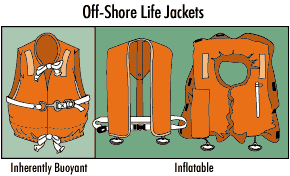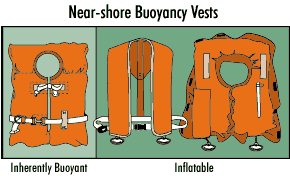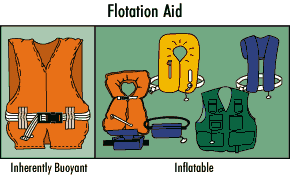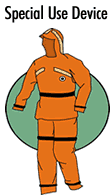
Personal Flotation Devices
All recreational boats must carry one wearable PFD (Type I, II, III or V PFD) for each person aboard. A Type V PFD provides performance of a Type I, II, or III PFD (as marked on its label) and must be used according to the label requirements. Any boat 16ft and longer (except canoes and kayaks) must also carry one Throwable PFD (Type IV PFD).
PFDs must be
Coast Guard approved, in good and serviceable condition, and the appropriate size for the intended user.
Accessibility
Wearable PFDs must be readily accessible. You must be able to put them on in a reasonable amount of time in an emergency (vessel sinking, on fire, etc.). They should not be stowed in plastic bags, in locked or closed compartments or have other gear stowed on top of them. The best PFD is the one you will wear. Though not required, a PFD should be worn at all times when the vessel is underway. A wearable PFD may save your life, but only if you wear it. Throwable devices must be immediately available for use.
Inflatable PFDs
Child PFD approvals are based on the child's weight. Check the "User
Weight" on the label, or the approval statement that will read something
like "Approved for use on recreational boats and uninspected commercial
vessels not carrying passengers for hire, by persons weighing __ lbs".
They can be marked "less than 30", "30 to 50", "less than 50", or "50 to
90".
PFD requirements for certain boating activities under state laws
The Coast Guard recommends and many states require wearing PFDs:
There are three basic kinds of PFD flotation in the five types of PFDs with the following characteristics:
Inherently Buoyant (primarily Foam)
|
|
|
|
|
|
|
|
|
|
|
|
|
|
|
|
|
|
|
|
|
|
|
|
|
Inflatable
The most compact
|
|
|
|
|
|
|
|
Hybrid (Foam & Inflation)
|
|
|
|
|
|
|
|
|
|
|
|
|
|
|
|
|
|
|
|
Types of PFDs
A TYPE I PFD or OFFSHORE LIFE JACKET provide the most buoyancy. It is effective for all waters, especially open, rough or remote waters where rescue may be delayed. It is designed to turn most unconscious wearers in the water to a face-up position.

A TYPE II PFD or NEAR-SHORE BUOYANCY VEST is intended for calm, inland water or where there is a good chance of quick rescue. Inherent buoyant PFDs of this type will turn some unconscious wearers to a face-up position in the water, but the turning is not as pronounced as a Type I. this type of inflatable turns as well as a Type I foam PFD.

A TYPE III PFD or FLOTATION AID is good for conscious users in calm, inland water, or where there is a good chance of quick rescue. It is designed so wearers can place themselves in a face-up position in the water. The wearer may have to tilt their head back to avoid turning facedown in the water. The Type III foam vest has the same minimum buoyancy as a Type II PFD. It comes in many styles, colors, and sizes and is generally the most comfortable type for continuous wear. Float coats, fishing vests, and vests designed with features suitable for various sports activities are examples of this type PFD. This type inflatable turns as well as a Type II foam PFD.

A TYPE IV PFD or THROWABLE DEVICE is intended for calm, inland water with heavy boat traffic, where help is always present. It is designed to be thrown to a person in the water and grasped and held by the user until rescued -- It is not designed to be worn. Type IV devices include buoyant cushions, ring buoys, and horseshoe buoys. There are no inflatable Type IV devices.

A TYPE V PFD or SPECIAL USE DEVICE is intended for specific activities and may be carried instead of another PFD only if used according to the approval condition(s) on its label. A Type V PFD provides performance of a Type I, II, or III PFD (as marked on its label). If the label says the PFD is "approved only when worn" the PFD must be worn, except for persons in enclosed spaces and used in accordance with the approval label, to meet carriage requirements. Some Type V devices provide significant hypothermia protection. Varieties include deck suits, work vests, and board sailing vests.

2-Meter
Half Square I build Antenna part II
My Link to Ham'er and the world
Maps and my QTH
My life in pictures Second Link page Navigation rules Personal Floatation Device
Latitude
Longitude & Bearing US State & Cities HF
Loop antenna